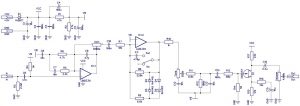
Convolvulaceae
Yet another one of my favourite effect types: a low gain overdrive. There is already a post about the Sweet Honey (one of my all time favorites and a permanent member of my board), and now here is another little gem, the JHS Morning Glory. The predecessor of the pedal is the Marshall Bluesbreaker, but JHS has enhanced it a bit: the output level is higher and there is an added bright switch. The sound… Well, I could praise it for weeks, but I don’t do it. It indeed is very tube-like, dynamic, open and well defined. One little drawback is that it eats up some of your lower frequencies, but usually guitars are not really used in that region. It can be boosted very well and thus reacts to turning down the volume pot of your guitar really well too. Highly recommended for blues or lighter rock, but can be used in heavier music too either boosted or as a booster.
 The circuit relies on the old Marshall Bluesbreaker schematic. It actually is a copy, except that it is true bypass and that there is a FET booster end stage to increase the signal level. This latter is built around the today already obsolete 2N5457, but you can substitute it with another FET transistor, you just have to rebias it. For that use a 100k pot instead R17 to find the correct drain resisor value (careful, R17 shouldn’t be zero, as that could damage your transistor, so don’t turn the pot all the way down). Optionally you could use an SMD transistor here, MMBF5457, the SMD equivalent of 2N5457 is readily available. You only need to get yourself one of those SMD conversion PCBs. You can mod the effect the usual way with changing the dcoupling caps, the filters, the clipping diodes or the IC itself. I have found the original’s LM833 a bit too noisy sometimes, a TL062 provided better results, or you can even try a higher end Burr-Brown IC too. I have not tried this, but it might make sense to try to get some more low frequencies back to the signal by increasing C7 and C8 or increasing the decoupling caps. The build documentation can be downloaded from the Projects menu.
The circuit relies on the old Marshall Bluesbreaker schematic. It actually is a copy, except that it is true bypass and that there is a FET booster end stage to increase the signal level. This latter is built around the today already obsolete 2N5457, but you can substitute it with another FET transistor, you just have to rebias it. For that use a 100k pot instead R17 to find the correct drain resisor value (careful, R17 shouldn’t be zero, as that could damage your transistor, so don’t turn the pot all the way down). Optionally you could use an SMD transistor here, MMBF5457, the SMD equivalent of 2N5457 is readily available. You only need to get yourself one of those SMD conversion PCBs. You can mod the effect the usual way with changing the dcoupling caps, the filters, the clipping diodes or the IC itself. I have found the original’s LM833 a bit too noisy sometimes, a TL062 provided better results, or you can even try a higher end Burr-Brown IC too. I have not tried this, but it might make sense to try to get some more low frequencies back to the signal by increasing C7 and C8 or increasing the decoupling caps. The build documentation can be downloaded from the Projects menu.


No Comments